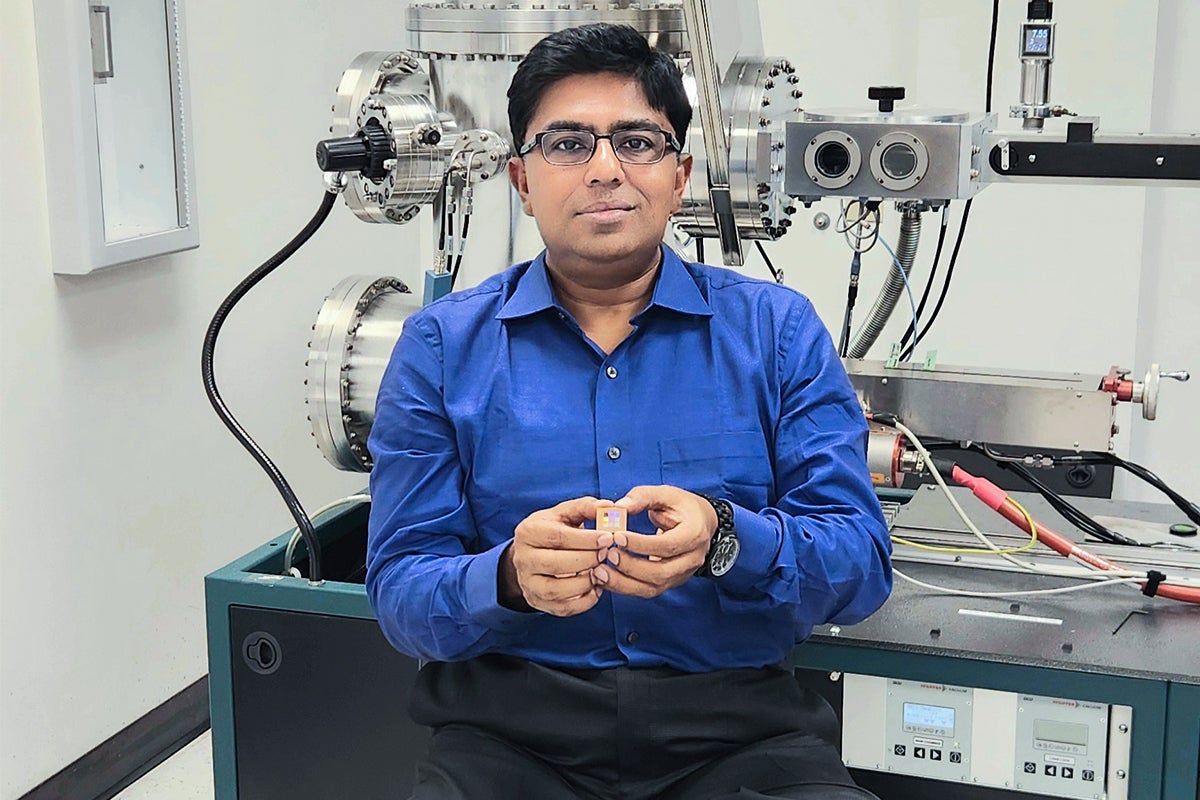UCF Researchers Develop Unique ‘Barcodes’ for Molecules to Help Expedite Medical Advancements
Barcodes are commonly used to track items like groceries or clothing, but UCF researchers have developed a special “barcode” to identify much smaller objects: molecules.
UCF researchers, led by UCF NanoScience Technology Center Professor Debashis Chanda, developed a “barcoding” technique to quickly identify chiral molecules based on their unique infrared fingerprints, potentially speeding up pharmaceutical and medical advancements.
The molecules can be identified using a special pixelated 2D sensor array that interacts with precise light with the specific properties of the molecules to capture their unique vibrational absorptions, which are then mapped as a barcode.
The study was funded by the U.S. National Science Foundation and was recently published in Advanced Materials.

Chiral molecules are pairs that are similar in structure but are twisted differently (left or right), like how a person’s left and right hands are mirror images of each other. Understanding the nature of chiral molecules is crucial to biological and pharmaceutical research because the mirror image pairs — known as enantiomers — can each have different effects in the body or in chemical reactions.
Nearly 56% of all modern drugs and medicine are chiral in nature, and about 90% of those are a mixture containing equal amounts of two enantiomers of a chiral compound. Researchers often face the challenge of separating enantiomers or synthesizing only the desired enantiomer to ensure optimal therapeutic outcomes and minimize adverse effects.
Most modern medicines and drugs are chiral and are marketed as racemates (equal mixtures of enantiomers), which in some cases can have unwanted consequences, Chanda says. This highlights the need for techniques that can identify such molecules reliably and accurately.
“On molecular adsorption, the combined system’s response depends on the degree and positional overlap of the molecule’s absorbance and sensor resonance,” Chanda says. “The measured signal is analyzed and encoded to generate a ‘chiral barcode’ for uniquely identifying the adsorbed chiral molecule. We show applicability of the platform by analyzing and generating unique chirality-based barcodes for an enantiomeric pair of small molecules, as well as a pair of spectrally similar larger chiral biomolecules based on very low volumes of analytes at ultra-low concentrations.”
The sensing platform is made of specially engineered nanopatterned gold where the interactions between the plasmonic and photonic cavity modes produce strong chiral “superchiral” light, he says.
By changing the geometrical parameters, 25 of such spectrally de-tuned sensors in 5×5 array was produced. When a molecule is added to this array, each sensing element produces slightly different chiral response, resulting in a unique barcode.
“Unlike other existing platforms that require chiral nanostructures of varying asymmetries that can be difficult to replicate, our proposed system’s inherent achirality overcomes this problem, greatly simplifying the fabrication process,” says Aritra Biswas ’12MS ’24PhD, postdoctoral fellow and lead author of the paper. “Additionally, the sensors are fabricated by simple nanoimprint lithography and two deposition steps, therefore making them very robust. We envision that such a versatile, low footprint, mass manufacturable platform would be a crucial tool for drug and biomolecular identification with applications in medical research and pharmaceutical industries.”
“We aim to contribute towards the development of inexpensive and sensitive chiral drug identification methods for chemical, biological and medical research, the fabrication of novel devices exhibiting superior light-matter interaction and the demonstration of a real product with commercial viability,” Chanda says.
Postdoctoral fellow Pablo Cencillo-Abad also contributed to the research and is listed as a study co-author.
Those interested in licensing this technology may learn more here.
Researcher’s Credentials:
Chanda has joint appointments in UCF’s NanoScience Technology Center, Department of Physics and CREOL, the College of Optics and Photonics. He received his doctoral degree in photonics from the University of Toronto and worked as a postdoctoral fellow at the University of Illinois at Urbana-Champaign. He joined UCF in Fall 2012.
Latest Research
- U.S. Army Awards $1M Grant to UCF for Development of Semiconductor Light SourceThe laser device could be used for defense applications and civilian purposes, including room disinfection and water sterilization.
- UCF Fuels America’s Space Program with Innovative Education, Medicine and TechUCF is advancing cutting-edge space research while offering unique opportunities for students to launch their careers in the space industry.
- New UCF-Siemens Energy Pegasus Partnership to Grow Inventive Sustainable Energy Research, Expand Educational OpportunitiesSiemens Energy intends to invest a minimum of $5 million additional dollars, mostly to boost UCF’s research in the energy sector and also in talent development and executive education initiatives.
- Universities, Defense Agencies Collaborate on Research at Inaugural Florida Symposium Hosted by UCFUCF and the University of South Florida facilitated a two-day symposium where faculty from Florida universities and U.S. Department of Defense research and development officers collaborated on advancing critical technologies.
- UCF, U.S. Air Force Partner on Center of Excellence to Advance Hypersonics, Space PropulsionAdvanced hypersonic propulsion systems are a national priority and are essential to maintaining U.S. national defense as global technological advancements continue to evolve.
- 3 UCF-connected Experts to Be Inducted Into the 2024 National Center for Simulation Hall of FameEstablished in 2014, the Modeling & Simulation Hall of Fame recognizes accomplishments and contributions of individuals who have pioneered the development of modeling and simulation.













